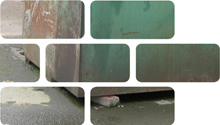
Oils Hazardous Various six-digit EWC Codes
All waste oils (except edible oil) are absolute hazardous waste oils and must be consigned as hazardous (or special) waste. They arise in a wide range of types, colours and containers depending on their intended or former use. Hazardous oils include engine oil, gear oil, lubricating oil, machine oil, hydraulic oil, fuel oil, mixed oil, insulating oil, heat-transfer oil and water/oil mixtures. They may be of varying age, condition and contamination depending on where and how they have been stored or used and if the container has been compromised. Beware of oils in containers where the cap, lid or screw-top is poorly fitting to avoid spillage. Note: Choose the correct six-digit European Waste Catalogue Code from the Environment Agency 'List of Waste Codes' depending on if they are chlorinated, mineral, synthetic, biodegradable or other. This DRIDS Excludes Non-Hazardous Edible Oils.
Usage & Probable Locations
Oil is used for cooling, heating lubricating and fueling engines, machines, plant and equipment, transformer insulator. Oil is packaged or stored in containers that are made from metal or plastic in a wide range of styles, sizes and volumes. Packaged containers are commonly marked with the supplier's name, brand, type and intended use, whereas stored oils may only be in colour coded containers marked with a hazardous symbol. Oils in containers are commonly found in cupboards, store rooms, maintenance depots, basements, besides machinery or in external tanks. Oils may also display the Control of Substances Hazardous to Health (COSHH) international symbol - refer to Further Reading
Personal Protective Equipment
PPE requirements indicated are for guidance purposes only. DRIDS has identified the PPE that is mandatory on all demolition projects and ones that may be required subject to site specific Risk Assessment & Method Statement (RAMS). Hover over the icon to determine the types of PPE required for the removal of this material.
Removal, Segregation & Storage
Hazardous oils in containers should be segregated and stored carefully and safely to ensure their integrity and good condition. The containers should be stacked on separate pallets or within other containers to prevent damage and contain spills. Preferably they should be stored inside a building or under cover before removal from site. Hazardous oils should be stored, prepared and transferred as defined by the Hazardous Waste Regulations. They should be consigned, handled and treated appropriately as defined by the EA in England & Wales, SEPA in Scotland and EHS in Northern Ireland.
Tools
Fixtures, Fittings & Connections
Health & Safety
Subject to task-specific Risk Assessment & Method Statement (RAMS). Wear gloves and face mask when handling oils in containers to prevent irritation, ingestion, splashes, cuts and abrasion. Use eye protection when using hand tools to seal lids or disconnect tanks. Wash hands before eating or drinking. Be alert to hazardous oils and their correct symbols in order to recognise and treat them accordingly. Be aware of dermatitis and use correct personal protection and treatment if exposed. Fuel oils need specialist handling and training.
Further reading
- NetRegs - Managing your hazardous/special wastes
- _special_waste/treatdispose_of_special_waste.aspx
- EA SEPA & EHS - Safe Storage & Disposal of Waste Oils
- EA Waste classification and hazardous waste
- EA Identifying hazardous and non-hazardous oils
- EA Waste Classification and Hazardous Wastes
- CSG Search Engine for the European Waste Catalogue Codes
- EA Waste Oil Treatment and Storage Activities
- EA Waste Oils Storage Regulations










